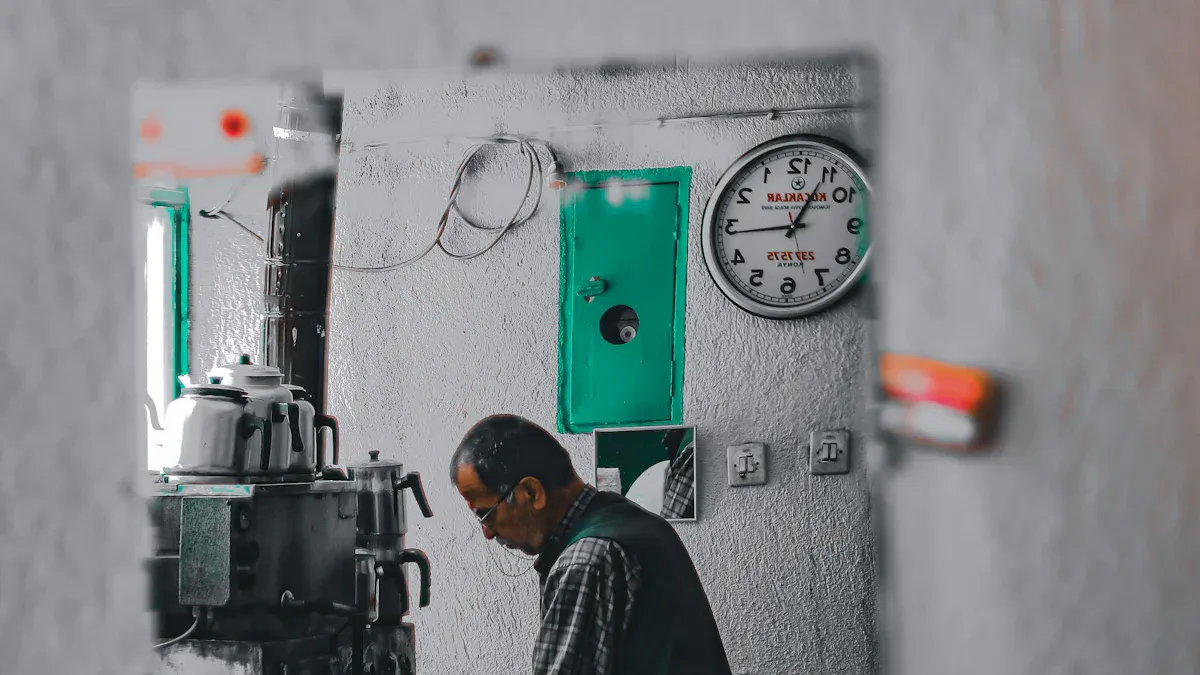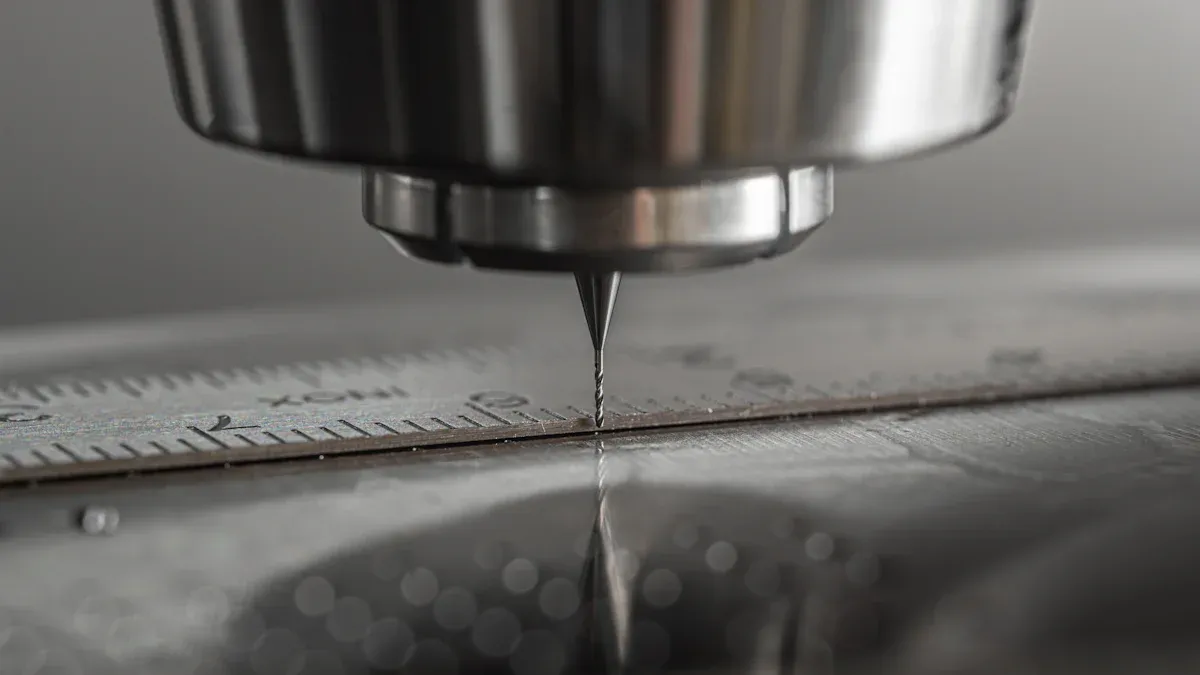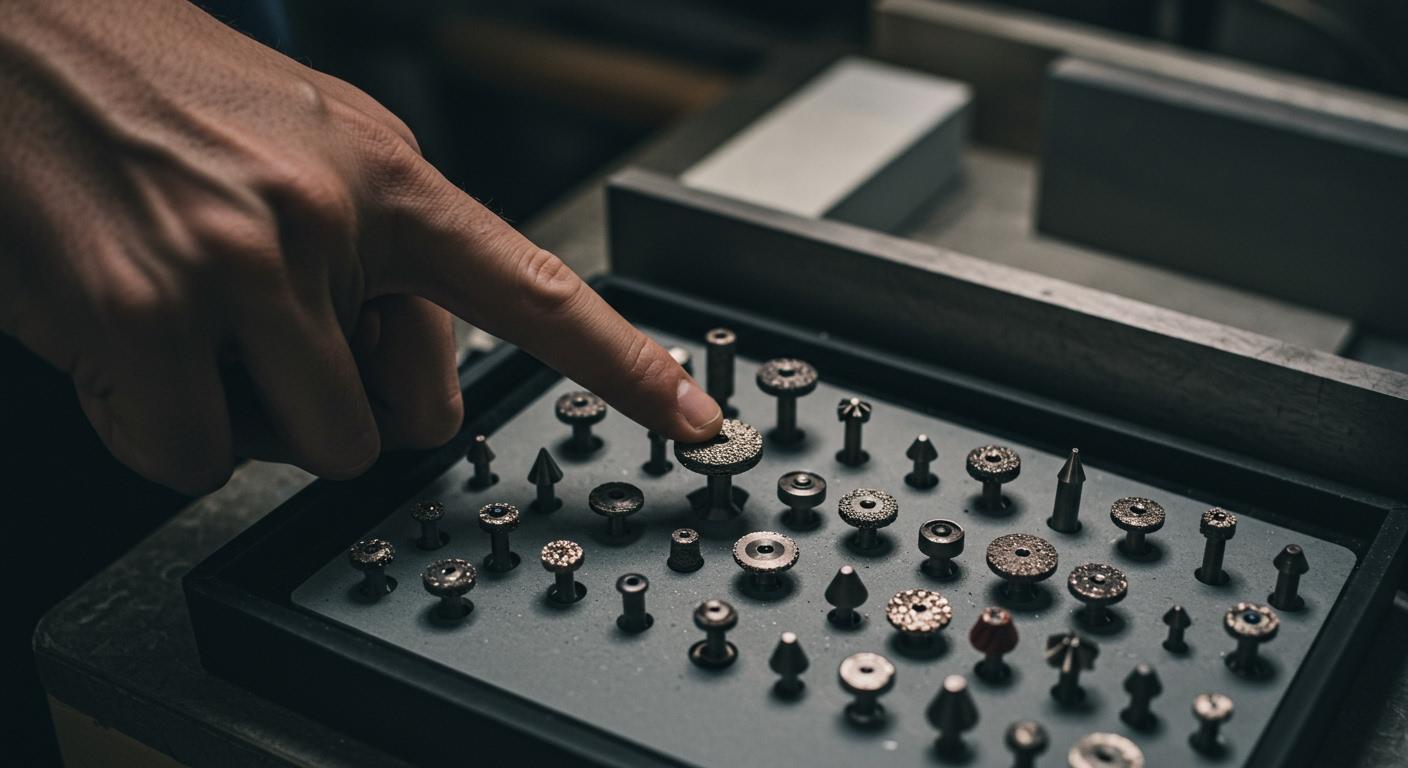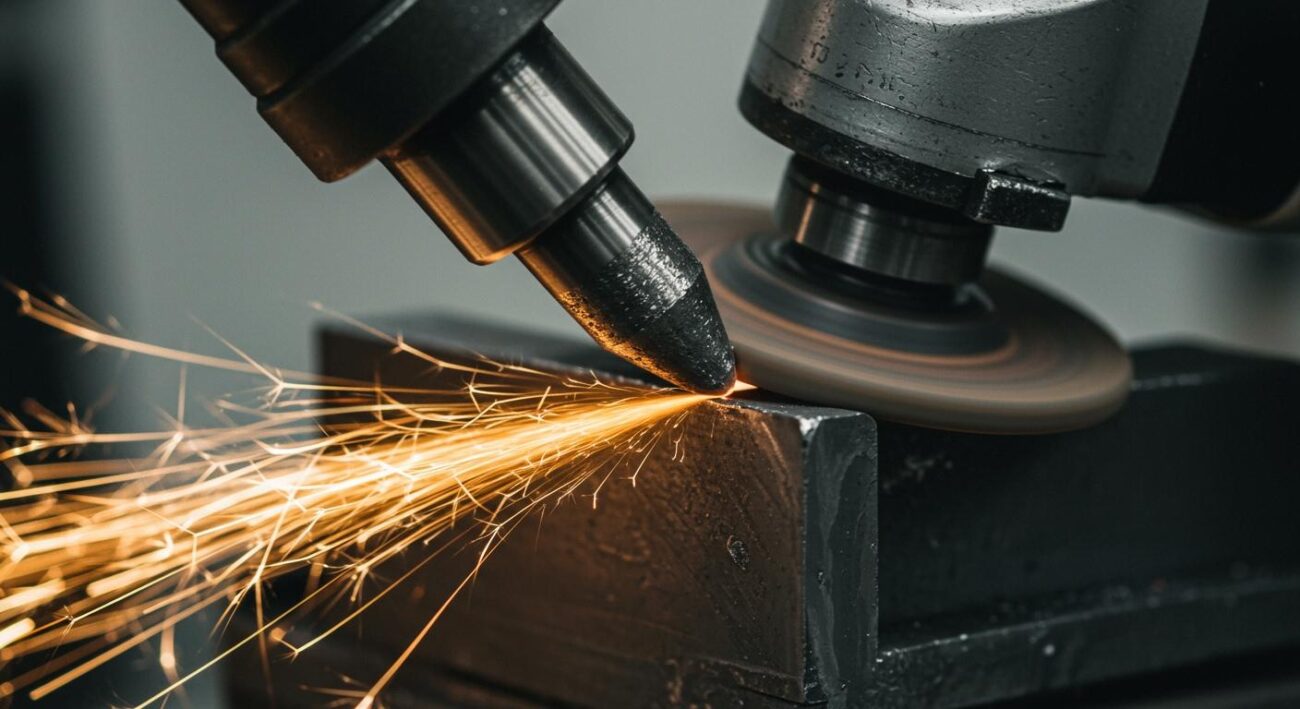Selecting the perfect grinding tool requires you to match the pin’s grit, shape, bond, and shank size to your specific material. Choosing the right grinding tool is essential. It helps you create a professional finish and get more value from a durable diamond tool.
Benefit: A proper match prevents workpiece damage and saves money over time.
With the diamond tools market projected to reach USD 19.5 billion by 2034, knowing how to pick the correct diamond grinding pin is a valuable skill for any project.
Key Takeaways
- Match the diamond pin’s grit to your material and desired finish. Coarse grit removes a lot of material. Fine grit makes surfaces smooth.
- Choose the right pin shape for your task. Different shapes like ball, cylinder, or pointed pins do different jobs.
- Consider the bond type. Softer bonds work for delicate materials. Stronger bonds are for hard materials like stone or steel.
- Make sure the pin’s shank fits your tool. The shank is the part that goes into your rotary tool.
- Use proper speed and lubricants. This helps your diamond tools last longer and work better.
Key Factors for Your Diamond Grinding Pin

Choosing the correct diamond tooling involves four key decisions. You must consider the pin’s grit, shape, bond, and shank size. Getting these factors right ensures your project succeeds.
Match Grit to Material and Finish
The grit of a diamond grinding pin determines its abrasiveness. You should select a grit based on your material and desired finish. Diamond abrasives are sorted into three main categories:
- Coarse (40-120 Grit): Use this for rapid material removal and rough shaping.
- Medium (150-400 Grit): This range offers a balance between removal speed and surface finish. It is ideal for general-purpose grinding.
- Fine/Superfine (500+ Grit): Choose fine grits for polishing and achieving a very smooth surface.
For example, when working with tungsten carbide, a coarse diamond grit is best for heavy stock removal. A medium grit works well for general sharpening. You would use a fine diamond grit for precision finishing. The grit number indicates the particle size. A lower number means a coarser grit.
Tip: Grit sizes are standardized. This helps you compare different diamond tools.
U.S. Standard ASTM-E-11 FEPA Standard (Diamond) 60/70 D251 120/140 D151 270/325 D64 500 D46 800 D22-36
Select the Right Shape for the Task
The shape of your diamond grinding pin affects how it interacts with your workpiece. Each shape has a specific purpose.
- Ball: Perfect for carving, hollowing, and creating concave cuts.
- Cylinder: Ideal for shaping flat surfaces and side grinding.
- Tapered/Pointed: Use these for detailed engraving, V-cuts, and reaching tight corners.
- Flame: Excellent for contouring and creating unique edge profiles.
Consider the Bond Type
The bond holds the diamond particles to the tool. Resin bonds are softer and work well for materials that need a delicate touch. For harder materials, you need a stronger bond. Metal bonds, like those found in Aimgrind‘s durable diamond tooling, provide the toughness required for grinding stone, ceramics, and hardened steel. Electroplated diamond tools are a great example. They are suitable for materials like glass, carbide, and various composites.
Ensure the Shank Fits Your Tool
The shank is the part of the pin that fits into your rotary tool. You must ensure the shank diameter matches your tool’s collet. Common shank sizes include:
- 1/8″ (3.175mm)
- 3/32″ (2.35mm)
Always check your rotary tool’s specifications before buying a new pin. The shank material also matters. A rigid carbide shank can reduce vibration better than a steel one, improving stability and finish.
Choosing the Right Grinding Tool for Your Project

Now you know the four key factors for selection. Let’s apply that knowledge to some common projects. Finding the right grinding tool becomes simple when you match it to the job.
Engraving Glass and Crystal
Engraving delicate materials like glass and crystal requires precision and control. You need a tool that removes material cleanly without causing cracks or chips.
- Grit: Start with a fine grit (400-600) for smooth lines. A superfine grit (800+) can help you polish the engraved area.
- Shape: A pointed or small ball-shaped diamond pin gives you excellent control for detailed work and fine lines.
- Bond: An electroplated bond is perfect here. It provides a sharp cutting action that is ideal for the brittle nature of glass.
Pro Tip: Always use a lubricant, like water, when working on glass. It keeps the surface cool, reduces dust, and helps you achieve a cleaner cut.
Shaping Stone and Ceramics
Shaping hard materials like stone, granite, or ceramic tiles demands durable diamond tooling. The process involves removing a significant amount of material and then refining the surface. Choosing the right grinding tool is crucial for a professional finish.
For a project like shaping a granite countertop edge, you should:
- Work in Stages: Start with a coarse grit diamond tool (around 60) for initial shaping. Then, progress through medium and fine grits. Do not skip grits, as this can leave deep scratches that are hard to remove.
- Use Water: Wet grinding is essential. Water cools the diamond tool and the stone, preventing cracks from heat. It also minimizes harmful dust.
- Keep Moving: Avoid holding the tool in one spot. Use light, even strokes to prevent grooves and create a uniform surface.
The best combination for this task is a coarse-to-medium grit diamond tool with a strong metal bond for shaping. You will then switch to finer grit resin-bond pads for polishing.
Deburring Hardened Steel
After cutting or machining hardened steel, you are often left with small, sharp edges called burrs. Deburring removes these imperfections, creating a safe and finished part. You need tough diamond tooling to handle this job effectively.
- Grit: A medium grit (150-220) is usually sufficient to remove burrs without taking off too much material.
- Shape: A cylinder or tapered shape works well for cleaning up flat edges and corners.
- Bond: A metal bond is necessary to stand up to the hardness of the steel.
Safety First! 🛡️
Your safety is the top priority. Always wear safety glasses, gloves, and a dust mask. Work in a well-ventilated area to avoid inhaling particles. Inspect your workpiece first and make sure you are using the correct tool for the job.
Grinding and Finishing with Aimgrind Tools
Finding the optimal grinding tool means getting the perfect combination of grit, shape, and bond. For specialized tasks in glass processing, ceramics, and metalworking, a one-size-fits-all approach is not enough. This is where customized solutions make a difference.
Aimgrind’s range of diamond grinding tools offers the precision and durability needed for these demanding applications. With nearly two decades of experience, we provide personalized diamond tooling designed for your specific material. Whether you are engraving delicate crystal or deburring hardened steel, our experts help you select the ideal tool. Our commitment to quality ensures you achieve a superior finish and enhance your productivity. Trust Aimgrind to help you grind with passion and achieve with aim.
Best Practices for Using Your Diamond Tools
You can get the most out of your diamond tooling by following a few best practices. Proper use and care will extend the life of your tools and improve your results.
Using Proper Speed (RPM)
Your tool’s operating speed greatly affects its lifespan. Running a diamond pin at a speed that is too high generates excess heat. This heat can damage the bonding material and the diamond particles, shortening the tool’s life. Excessive speed can even cause cracks in the tool. You will know your tool is overheating if you see discoloration on its core. Always match your tool’s RPM to the material to ensure efficient cutting and prevent unnecessary stress.
The Role of Lubricants
Lubricants are essential for extending the life of your grinding pins. They prevent overheating and flush away debris from the work surface. This action reduces clogging and helps you cut faster and longer. You have two main options for coolants:
- Water-based coolants are simple and cost-effective. They do an excellent job of pulling heat away from your workpiece.
- Oil-based coolants offer superior lubrication. They reduce friction, which means less heat is generated in the first place. Oil coolants often increase the life of a diamond grinding wheel and are preferred for high-performance jobs.
In industrial settings, professionals run diamond and CBN wheels with continuous lubrication. This practice helps the tools cut faster and last much longer.
Tool Maintenance and Lifespan
Proper maintenance ensures your diamond tooling performs at its best. You should always clean your tools after each use to remove debris. Applying moderate, even pressure while you work also prevents unnecessary wear.
Eventually, every tool wears out. You will know it is time for a replacement when you notice:
- The grinding process takes much longer than it used to.
- The tool generates excessive heat.
- The sound of the tool changes to a higher pitch.
- You see an inconsistent scratch pattern on your workpiece.
Paying attention to these signs helps you replace your tools before they can damage your project.
Choosing the right diamond grinding pin is simple when you focus on the key factors. You must match the grit, shape, bond, and shank size to your project. Finding the right grinding tool involves balancing your material with your task. This prevents common mistakes that shorten a diamond tool’s life. As technology advances, high-performance diamond tools offer greater precision. You can now confidently select the perfect tool for your needs. For specialized projects, explore custom solutions from experts like Aimgrind to achieve professional results.
FAQ
See Also
Selecting the Perfect Metal Grinding Wheel for Your Specific Project
Optimal Grinding Wheel Selection for Sharpening Carbide Tooling Effectively
Picking the Ideal Grinding Wheel for Your Circular Saw Blade
Selecting the Best Bench Grinding Wheel Material to Suit Your Requirements
Discovering the Most Effective Grinding Wheel Dresser for Your Workshop
Contact Us
For More Grinding Solution or Customized Abrasive Tools



